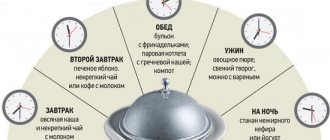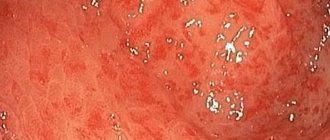Classification of gastritis
Gastritis can be acute or chronic. Both diseases differ in duration, course, causes and symptoms. In addition, acute gastritis can be cured, but it is impossible to get rid of chronic gastritis; with the help of nutritional correction and treatment, you can only achieve stable remission (temporary weakening or complete disappearance of symptoms).
Acute gastritis is an acute inflammation of the gastric mucosa that occurs due to exposure to a strong irritant that enters the stomach cavity.
Chronic gastritis is a disease characterized by chronic inflammation of the gastric mucosa with the gradual development of atrophy (reduction in the size and weight of an organ or tissue with weakening or complete cessation of their activity) of the gastric glands, which leads to a deterioration in the functions of the stomach. It is often accompanied by duodenitis - inflammation of the duodenal mucosa. The combination of gastritis and duodenitis is called gastroduodenitis.
Chronic gastritis has its own classifications, so it is worth talking about it separately.
Diagnostic methods
To confirm the diagnosis, diagnostic methods such as:
When conducting an X-ray examination with a contrast agent, barium stasis is observed during gastrostasis. During fibrogastroscopy, no organic lesions of the stomach are detected, there is no peristalsis in the antrum of the organ, and food residues may be detected in the cavity of the organ. During manometry, it is possible to detect a decrease in gastric motility in its antrum.
We recommend that you find out what medications are used to treat alcoholic gastritis.
Chronic gastritis
According to the causes of chronic gastritis, there are:
- Primary (exogenous). As an independent disease.
- Secondary (endogenous). As one of the manifestations of other somatic pathologies.
By localization:
- Focal (fundal). When it affects the bottom of the stomach;
- Common. Affects several sections, most or all of the stomach (pangastritis);
- Combined (gastroduodenitis). It causes inflammation of the stomach and duodenum.
With the flow:
- Latent (hidden, asymptomatic);
- Monotonous (symptoms are always present);
- Recurrent (alternate periods of exacerbations and remissions).
By stages (phases) of the process:
- Exacerbation (severe symptoms);
- Incomplete clinical remission (unexpressed symptoms, inflammation of the stomach is visible during FGDS);
- Clinical remission (there are no symptoms, but during FGDS inflammation of the mucous membrane is detected);
- Clinical and endoscopic remission (no symptoms, no traces of inflammation during instrumental examination).
According to changes in the mucous membrane:
- Superficial (without atrophy);
- Hypertrophic (with the growth of the mucous membrane, the formation of cysts and polyps);
- Hemorrhagic (tendency to bleeding from the walls of the stomach);
- Erosive (with the formation of stomach ulcers);
- Subatrophic (slow small-focal atrophy);
- Atrophic;
- Mixed.
Development mechanisms
Causes of acute gastritis in children:
- Foodborne illness (a gastrointestinal disease that occurs after eating food containing bacteria and their toxins. Often occurs due to the consumption of rotten foods, unwashed fruits or dirty water);
- Long-term use of certain medications (salicylates, sulfonamides, glucocorticoids, digitalis preparations, etc.);
- Poisoning with household poisons;
- Allergy.
When a large number of bacteria enter the gastrointestinal tract, inflammation occurs. Excess fatty, spicy and poorly chewed food slows down the evacuation (removal) of stomach contents and worsens the secretory function of the organ (the secretion of digestive juice for digesting food). The food lump lingers in the stomach, it is saturated with enzymes, after which it disintegrates due to the action of bacteria, and the fermentation process begins.
Which leads to aggravation of the course and chronicity of the process.
Causes of chronic gastritis in children:
- The presence of the bacterial flora Helicobacter pylori (the same bacterium leads to ulcers). In 80-85% of cases it is what causes gastritis;
- Poor nutrition (eating rough, too hot or cold, fatty, spicy or poorly chewed food);
- Dry food;
- Eating 1-2 times a day or less often;
- Lack of vitamins, complete proteins and fats in the diet;
- Endocrine diseases;
- Kidney damage;
- Diseases of the cardiovascular system;
- Long-term use of medications (salicylates, sulfonamides);
- The source of infection in the oral cavity (disease of teeth and gums);
- Burdened heredity;
- Allergies.
The factors that cause acute and chronic gastritis are similar or even coincide. The main difference is the duration of their effect on the body. In acute gastritis, one contact with an irritant (expired cottage cheese or a large portion of fast food) is enough for an attack. In chronic gastritis, an irritating factor acts on the gastric mucosa for a long time and repeatedly, gradually leading to a decrease in the activity of the digestive glands.
Symptoms of gastritis
Manifestations of acute gastritis begin to bother the child 8-12 hours after exposure to the etiological (causal) factor. Intoxication in children is more pronounced than in adults, so the clinical picture in children is more pronounced than in adolescents and adults.
The main symptoms of acute gastritis in children:
- General malaise (the child becomes lethargic, moody, sleepy or restless);
- Pale skin;
- Loss of appetite;
- Nausea and vomiting;
- Feeling of fullness or pain in the epigastrium (upper abdomen, above the navel);
- Chills;
- Increase in body temperature to 38°C;
- Belching with an unpleasant odor;
- Short-term diarrhea.
The duration of the disease is from 2 to 10 days.
Complaints from patients with chronic gastritis may be absent if the digestive process is not disturbed. That is, the mucous membrane is affected, but the compensatory mechanisms are sufficient to maintain the normal secretory function of the stomach, so that the person does not feel discomfort or changes in the gastrointestinal tract.
A clear clinical picture is characteristic of the exacerbation stage.
The main symptoms of chronic gastritis:
- Abdominal pain after eating (subsides within 1-2 hours);
- Feeling of heaviness in the epigastrium (upper abdomen, above the navel);
- Belching;
- Heartburn (discomfort and burning sensation behind the sternum);
- Unpleasant taste in the mouth;
- Vomiting, diarrhea (diarrhea), flatulence (bloating) are rare.
The duration of exacerbation ranges from several days to several months.
Diagnostics
Gastritis in children is treated by a pediatric gastroenterologist, but patients initially turn to a pediatrician, who refers the child for examination and then to a specialist.
At the appointment, the gastroenterologist interviews the child and parents to find out what is bothering the patient. In addition to assessing the data obtained, the doctor conducts an examination and identifies additional symptoms of gastritis in children:
- Moderate pain on palpation (palpation) of the epigastric region (upper abdomen);
- White coating on the tongue;
- Flatulence (bloating);
- Rumbling and feeling of “transfusion” in the stomach.
Interpretation of child tests by pediatricians online
cost of service: 500 rubles
Order
The pediatrician will interpret the tests during an online call using the Zoom or WhatsApp application.
- detailed explanation from the pediatrician.
- an alternative opinion from a competent specialist in interpreting the analyses.
- the opportunity to ask questions to the doctor regarding test results.
Additional diagnostic methods for gastritis:
- Complete blood count (signs of inflammation: leukocytosis - increased white blood cells, increased ESR).
- Biochemical blood test (markers of damage to other organs).
- Coprogram (determination of fat in feces, digested muscle fibers, occult blood).
- Fibrogastroduodenoscopy (FGDS). Visual assessment of the condition of the gastric mucosa. If necessary, a biopsy is simultaneously performed (a piece of tissue is taken) for histological examination. In the laboratory, the nature of the cells in the biomaterial is determined (cancerous or not).
- Fractional study of gastric contents. The stomach glands are artificially irritated with drugs, then the amount of enzymes they produce, hydrochloric acid and the pH level (acidity) are assessed.
- X-ray of the stomach. Changes in the relief of the gastric mucosa and its motor function are assessed.
- Electrogastrogram. The muscular activity of the stomach, that is, its motility, is studied.
A conclusion is drawn about the secretory, acid- and enzyme-forming functions of the organ.
Online consultation with a pediatrician
consultation cost: 500 rubles
Online consultation
During the consultation, you will be able to voice your problem, the doctor will clarify the situation, interpret the tests, answer your questions and give the necessary recommendations.
Gastrostasis prevention
In cases of sudden expansion of the stomach, atony and thinning of its wall with gastrostasis of any origin, as well as if conservative treatment is ineffective, surgical intervention is indicated. The best method of surgery is gastric resection. If there is a significant risk of surgery, it is permissible to perform stomach drainage operations: gastrojejunal anastomosis (after vagotomy with gastroduodenoanastomosis or pyloroplasty); gastroduodenoanastomosis; pyloroduodenoplasty (after isolated PPV).
Prevention of gastrostasis consists in correctly performing the operation, carrying out a set of conservative measures aimed at restoring the motor function of the vagotomized stomach from the first day of the postoperative period.
As for prevention, in order not to aggravate the situation of the operated patient, rehabilitation measures must be correctly carried out to reduce negative consequences - this is the task of doctors. Diet, the principles of healthy eating and lifestyle are what prevent this disease.
Source
Treatment
The treatment plan for gastritis in children depends on the form of the disease and its severity.
Therapy for acute gastritis includes:
- Bed rest for 2-3 days;
- Gastric lavage;
- Hunger in the first 8-12 hours after the onset of symptoms, then switching to liquid food (puree soups, low-fat broths, crackers without spices and salt, jelly and porridge), on days 5-7 the child is transferred to normal food;
- Drink plenty of fluids (preferably special solutions for rehydration);
- In case of severe dehydration, saline solution with 5% glucose solution is administered intravenously;
- Laxative for constipation;
- Antiemetics for vomiting;
- Antibiotics for infection;
- Additionally: B vitamins, enzymes for the gastrointestinal tract.
For chronic gastritis, the following is additionally prescribed:
- Eradication therapy (a special treatment regimen for the destruction of Helicobacter pylori (omeprazole + amoxicillin + imidazole/metranidazole/clarithromycin). Duration - 10 days. If ineffective, the regimen is changed.
- M-cholinergic receptor blocker to relax the smooth muscles of internal organs and suppress the secretion of the digestive glands.
- Antacids, histamine H2 receptor blockers to reduce gastric secretion.
Treatment is carried out until remission occurs, the duration of which is variable: from several months to several years.
What is gastrostasis of the stomach?
from gastritinform.ru
Gastric gastrostasis is a diagnosis that affects a person’s quality of life and sometimes makes it unbearable. Gastrostasis, the causes of which can often be the result of serious diseases, is not easy to treat; there is no single scheme. It all depends on the causes of gastrostasis; the treatment regimen is considered as a whole. The appearance of gastrostars may be preceded by stomach cancer, diabetes mellitus, and gastric atony. Today we will talk about what gastrostasis is, why it occurs, as well as methods of treating this disease. Read the following article on the pages of gastritinform.ru magazine.








